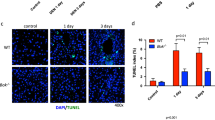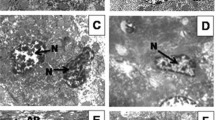Abstract
Objective
We explored the role and molecular mechanism of Microcystin-LR (MC-LR) in hepatocarcinogenesis.
Methods
The two-stage-medium-term theory was applied to the establishment of the animal model. The promoting effect of MC-LR on liver tumor was evaluated with the Albert γ-GT methods. During the tumor-promoting course, the effects of MC-LR on the regulation and expression of the Bcl-2 and Bax genes were studied with immunohistochemical technique and RT-PCR.
Results
MCLR could enhance the positive reaction of Albert γ-GT (GGT), a preneoplasm marker. The positive reaction rate of GGT in diethylnitrosamine (DEN) + MC group was significantly higher than that in the DEN control group. The protein and RNA expression of Bcl-2 was significantly increased by MC-LR, and that the protein expression of Bax was decreased simultaneously.
Conclusion
These results indicate that the MC-LR can inhabit apoptosis through the Bcl-2 and Bax genes. Therefore, we conclude that the expression change of Bcl-2 and Bax genes possibly plays an important role in the promotion of liver tumor by MC-LR.
Similar content being viewed by others
References
Yu SZ, Zhao N, Zi XL. The relationship between cyanotoxin (Microcystin, MC) in pond-ditch water and primary liver cancer in China. Chin J Oncol (Chinese), 2001, 23: 96–99.
Lian M, Liu Y, Yu SZ, et al. A cross-sectional study on the effects of microcystin in drinking water to the health of human beings. Chin J Epidemiol (Chinese), 2000, 21: 437–440.
Yang M, Huang M, Wong BS, et al. Effect of microcystins on phosphorylase- a binding to phosphatase-2A. Biochim Bipphys Acta, 1999, 1427: 62–73.
Lian M, Liu Y, Yu SZ, et al. Hepatitis B virus x gene and cyanobacterial toxins promote aflatoxin B1-induced hepatotumorigenesis in mice. World J Gastroenterol, 2006, 12: 3065–3072.
Zegura B, Lah TT, Filipic M. Alteration of intracellular GSH levels and its role in microcystin-LR-induced DNA damage in human hepatoma HepG2 cells. Mutat Res, 2006, 611: 25–33.
Portier BP, Taglialatela G. Bcl-2 localized at the nuclear compartment induces apoptosis after transient overexpression. J Biol Chem, 2006, 281: 40493–40502.
Chen T, Wang Q, Cui J, et al. Induction of apoptosis in mouse liver by microcystin-LR: a combined transcriptomic, proteomic, and simulation strategy. Mol Cell Proteomics, 2005, 4: 958–974.
Fu WY, Chen JP, Wang XM, et al. Altered expression of p53, Bcl-2 and Bax induced by microcystin-LR in vivo and in vitro. Toxicon, 2005, 46: 171–177.
Oh HM, Lee SJ, Jang MH, et al. Microcystin production by microcystis aeruginosa in a phosphorus-limited chemostat. Appl Environ Microbiol, 2000, 66: 176–179.
Rutenburg AM, Kim H, Fischbein JW, et al. Histochemical and ultrastructural demonstration of 7-glutamyl transpeptidase activity. J Histochem Cytochem, 1969, 17: 517–526.
Cameron R, Kellen J, Kolin A, et al. γ-glutamyltransferase in putative premalignant liver cell populations during hepatocarcinogenesis. Cancer Res, 1978, 38: 823–829.
Fawell JK, Mitchell RE, Hill RE, et al. The toxicity of cyanobacterial toxins in the mouse: I microcystin-LR. Hum Exp Toxicol, 1999, 18:162–167.
Tamm I, Schriever F, Dorken B. Apoptosis: implications of basic research for clinical oncology. Lancet Oncol, 2001, 2: 33–42.
Hatano E. Tumor necrosis factor signaling in hepatocyte apoptosis. J Gastroenterol Hepatol, 2007, Suppl 1: S43–44.
Reed JC, Green DR. Remodeling for demolition: changes in mitochondrial ultrastructure during apoptosis. Mol Cell, 2002, 9: 1–3.
Hahn P, Lindsten T, Lyubarsky A, et al. Deficiency of Bax and Bak protects photoreceptors from light damage in vivo. Cell Death Differ, 2004, 11: 1192–1197.
Lei XY, Zhang H, He DM. Apoptosis induced by Bcl-2 antisense peptide acid in HL60 cells. Chinese-German J Clin Oncol, 2003, 2: 36–39.
Author information
Authors and Affiliations
Corresponding author
Additional information
Supported by grants from the Natural Science Foundation of Fujian Province (No. C0710019) and the Science & Technology Program of Fuzhou (No. 2006S-G24).
Rights and permissions
About this article
Cite this article
Hu, Z., Chen, H., Xue, J. et al. The expression of Bcl-2 and Bax produced by sub-chronic intoxication with the cyanotoxin Microcystin-LR. Chin. -Ger. J. Clin. Oncol. 9, 68–72 (2010). https://doi.org/10.1007/s10330-009-0169-5
Received:
Revised:
Accepted:
Published:
Issue Date:
DOI: https://doi.org/10.1007/s10330-009-0169-5




